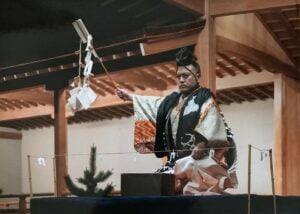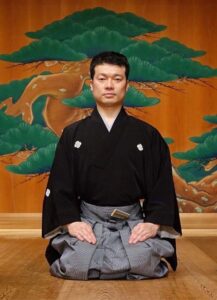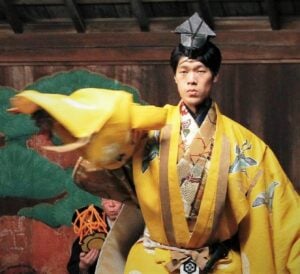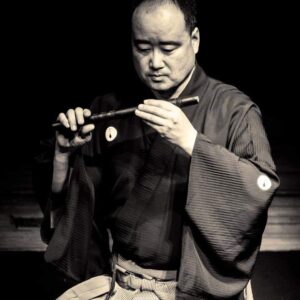Past event
Join the waiting list and be the first to find out if tickets become available.
“Why is Noh Theatre fascinating for you?”
“It is because Noh theatre is a unique form of stage art that depicts scenes through its music (hayashi) and distinctive intonation of chanting (utai, which includes singing and dialogue). It erases the expressions of the most important actors with Noh masks, and conversely, through these masks, it allows the soul of the character to possess them, enabling the powerful expression of various emotions.” (Shizuka Mikata, shite actor, Kanze School )
“Noh expresses the emotions and drama of people since ancient times through quintessentially original Japanese words and music.” (Tatsushi Narita, kotsuzumi shoulder drum, Ko School)
“After the climax of the Noh drama, filled with chants, dances, and music overflowing with heartfelt emotions, a moment of stillness, known as ‘shijima’ in Japanese, unfolds on the stage. It’s a moment we share with the audience, when something within their hearts begins to stir and connect with the essence of Noh. A truly sensational moment!!” (Seigo Mikuriya, waki actor, Hosho School)
“The way of movement, vocal expression, and overall body usage in Noh is profound, and as a result, even the same forms or chants can appear completely different depending on the actor or the viewer.” (Yasuki Kobayakawa, shite actor, Kanze School)
“In contrast to the Western approach of captivating viewers by complex and sophisticated movements, Noh relies on the idea that stillness can imbue even the smallest movements with great persuasiveness. Noh reduces the number of instruments to the utmost minimum, aiming to express the most beautiful sound of “silence It is intriguing and deeply resonate with people’s hearts.” (Tetsuya Yamamoto, otsuzumi hip drum, Okura School)
The event will last for approximately 1 hour
See below for pictures and details of all the Noh Performers who will be present at this event

Shizuka Mikata was born in Kyoto in 1966 the eldest son of the Noh actor Ken Mikata. Shizuka studied under Yusetsu Katayama, a Living National Treasure and received the Kyoto City Arts Newcomer Award (2001) and the Encouragement Award of the Kyoto Prefecture Cultural Prize (2004). Shizuka is praised for his “precise acting and rich sensitivity” which creates a unique aesthetic. He produces the Teatre Noh project which aims to create a new perspective on Noh by its choice of themes and spaces. His ultimate goal is to integrate modernity and tradition so as to keep Noh alive and relevant for today.

Seigo Mikuriya was born in 1973 in Kitakyushu City. In 1996, he became a student of the Shimogakari Hosho School while training as a stage performer at the National Noh Theatre. He was afterwards apprenticed under the late Hosho Kan (12th generation head of the Hosho school and Living National Treasure). Seigo has performed in important pieces such as Takasago, and the hidden masterpiece Choryo. He actively performs in Tokyo, his hometown of Kyushu, and has performed overseas in China, Greece, and Denmark.

Gasho Yamanaka was born into a traditional Noh family and made his stage debut at the age of two. Gisho is associated with the Umewaka kai. Gasho actively explores the profundity of Noh, and participates in diverse activities such as film and stage performances, as well as delivering lectures to audiences of all ages and levels of knowledge about Noh.

Born in 1976 in Tokyo, Kohei Kawaguchi the eldest son of the manga artist Kaiji Kawaguchi, has always been fascinated by Noh during his studies at Keio University, Kohei decided to follow the path of Noh and became an apprentice under the 56th Umewaka Rokuro (Umewaka Minoru Rohsetsu) in 2001. Kohei has performed many of the important Noh pieces including Okina, Sakkyo, Shojomidare, and Dojoji.

Yasuki Kobayakawa was born in 1990 and studied under his father, Osamu Kobayakawa, and the master, Masakuni Asami. His first performances were in the Noh play Eboshi-ori (2002) and the role of Chitose in the Noh play Okina (2003). After graduating from the Tokyo University of the Arts in 2013, he has performed noted roles in Shakkyo and Ran. More recently, in 2021, he performed in Dojoji.

Yasumitsu Kobayakawa is the brother of Yasuki Kobayakawa (see above). Yasumi was born in 1997 and also studied under his father, Osamu Kobayakawa, and the master, Masakuni Asami. Yasumitsu made his stage debut in 2000, performing in Tsuru-Kame. He continued to build his career with notable performances such as the role of Chitose (2007) and in the Noh play Eboshi-ori (2009). He graduated from the Tokyo University of the Arts and, in 2023, he performed in Shōjō.

Born in 1964 in Kobe, Tatsushi Narita learnt kotsuzumi under Hiroaki Sowa, a Living National Treasure. As one of the most sought-after kotsuzumi exponents, Narita has actively performed overseas, notably at the Metropolitan Museum in New York, the Athens Festival in Greece, and at the Concertgebouw in Amsterdam. He is a director of the Nohgaku Performers Association. In 2016, Narita received the prestigious Newcomer Award from the Japanese government.

Tetsuya Yamamoto was born in 1966 and was apprenticed under his father, Takashi Yamamoto, and the late Tadao Kamei, a Living National Treasure. His first Noh performance was in 1978 with Tsunemasa. In 1986, he performed in Okina, followed by Dojoji in 1988. In 2002, he co-founded the TTR Noh Project with Tatsushi Narita. The project received the Osaka Cultural Festival Award in 2017. Tetsuya received the Excellence Award of the 2018 Agency for Cultural Affairs Art Festival.

Yasuhiro Sako was born in 1966 in Hyogo Prefecture , and currently resides in Kyoto. Yasuhiro studied Nohkan under Ichikazu Sugi. Yasuhiro is a director of the Kyoto Nohgaku Hayashikata Association and organises “Koh-no-kai” group. He made his debut in 1990 performing in Yoshino Tenjin. Sako believes that Nohkan melodies have the power to awaken something deep within our bodies and memories, serving as a bridge between “time immemorial and the present”.
About Noh Reimagined
Curated and produced by Akiko Yanagisawa (Mu Arts) in partnership with Kings Place, Noh Reimagined festival unwraps the art of Noh, the iconic theatrical tradition that originated in fourteenth-century Japan.